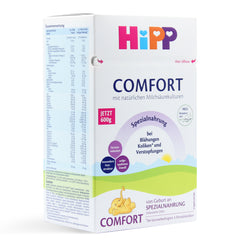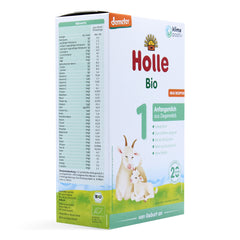Signs of Formula Intolerance vs. Allergy
Understanding Formula Intolerance vs. Allergy: What Every Parent Should Know
Your baby's piercing cries echo through the house again. The formula you trusted isn't working. Your little one is uncomfortable, gassy, and struggling after every feeding. You're exhausted, worried, and wondering what's wrong.
Many parents face this exact scenario. Signs of baby formula intolerance can appear suddenly, leaving you questioning everything about your feeding routine. Is it colic? Is it something more serious? The uncertainty is overwhelming.
Here's what most parents don't realize: signs of intolerance to formula are often mistaken for normal baby fussiness. Excessive spitting up, persistent gas, unusual crying patterns, and digestive issues aren't just "part of being a baby." They're your child's way of telling you something isn't right.
The difference between formula intolerance and a true allergy could mean the difference between sleepless nights and peaceful feeding times. Understanding these signs empowers you to make informed decisions about your baby's nutrition and comfort.
Your baby deserves better than constant discomfort. You deserve peace of mind.
Common Signs and Symptoms of Formula Intolerance
Baby formulas are created according to strict nutritional standards, yet some babies struggle with certain ingredients. Signs of baby formula intolerance can appear gradually, making them easy to miss initially. Unlike allergies, intolerance typically involves difficulty digesting cow's milk protein without triggering an immune response.
Formula intolerance signs often manifest through digestive and behavioral changes. Recognizing these symptoms early helps parents make informed feeding decisions for their baby's comfort and health.
-
Digestive Disruptions. Persistent digestive issues are primary signs of formula intolerance in babies. Your baby may experience bloating, cramping, and visible discomfort after feeding. These symptoms often worsen over time if the problematic formula continues.
-
Excessive Gas and Discomfort. Frequent gas buildup causes significant discomfort for intolerant babies. You'll notice increased burping, trapped gas, and restless sleep patterns. Your baby may draw their knees to their chest, signaling abdominal pain.
-
Bowel Movement Changes. Diarrhea is a telltale sign of formula intolerance. Loose, frequent stools often occur within hours of feeding. Conversely, some babies experience constipation or alternating bowel patterns.
-
Increased Fussiness and Crying. Unexplained irritability, especially after feedings, indicates possible intolerance. Your baby may seem inconsolable, resist feeding, or display general crankiness throughout the day.
-
Sleep Disruptions. Formula intolerance often interferes with sleep quality. Your baby may wake frequently, struggle to settle, or appear restless during nap times.
-
Spitting Up and Reflux. While some spitting up is normal, excessive reflux can signal intolerance. Watch for projectile vomiting, frequent regurgitation, or signs of throat irritation.
-
Skin Reactions. Some babies develop mild skin irritation, including rashes around the mouth or diaper area, though these are less common with intolerance versus true allergies.
Understanding these signs of formula intolerance in babies empowers parents to seek appropriate solutions. Formula intolerance doesn't pose serious health risks but significantly impacts your baby's comfort and your family's well-being. Early recognition leads to faster relief through proper formula selection.
What Does Formula Allergy Look Like? Recognizing Allergy Symptoms
For parents who care about their babies' health, choosing high-quality certified formulas is important. European-made formulas from trusted brands are excellent choices, because formulas contain hypoallergenic ingredients, and some are made from goat's milk.
Our company, Organic Life Start, offers a selection of the best European formulas that have undergone rigorous testing not only by the FDA and other companies, but also by mothers who have fed them to their children. We, the founders of Organic Life Start, are mothers just like you. We have raised several generations of children and choose only the best for them.
Allergic reactions are becoming increasingly common in babies from birth. Unlike intolerance, allergic reactions have many serious effects on baby health. Allergies can range from mild to severe conditions and complications. Here are the key baby formula allergy symptoms:
-
Skin reactions (rash, hives). The main symptom is skin reactions on the baby's body and face. Skin reactions typically include rashes, redness, and hives. They usually appear on the chest and face and may worsen over time.
-
Breathing problems. Breathing difficulties are another important symptom of allergic reactions. Babies may start coughing after feeding and develop stuffy noses. Parents notice wheezing and changes in the baby's breathing patterns.
-
Vomiting. Severe signs of formula allergy include vomiting and serious digestive problems. Babies may spit up frequently and vomit repeatedly. This process usually begins after feeding and may contain blood. Babies also experience constant diarrhea, crying, and fussiness.
-
Severe allergic reactions. The most dangerous feeding-related condition is severe allergic reactions. Parents often notice swelling of the lips, face, and eyes. This condition is extremely risky and requires immediate medical attention. Children experience difficulty breathing and may develop anaphylaxis. In emergencies, it's crucial to seek hospital care immediately.
How to Differentiate Between Intolerance and Allergy

Formula allergies in newborns are fairly common symptoms that affect nutrition. Parents need to understand the difference between allergy and intolerance symptoms for proper feeding decisions. And don't forget about communication with a doctor for recognizing these symptoms.
Both conditions can cause discomfort, but they have different symptoms and severity levels. Unlike allergies, intolerance doesn't cause serious harm and isn't dangerous. A clear comparison helps parents understand the difference when selecting formulas:
-
Formula intolerance. Formula intolerance often begins due to digestive difficulties. Children have trouble digesting certain ingredients in the formula. Usually, these ingredients include lactose, proteins, or other components. Children may not feel discomfort initially, but symptoms appear after a few days. Symptoms of formula intolerance include gas buildup and bloating. Children may cry and become fussy after feeding. Babies typically burp frequently and have loose stools several times daily. Other important symptoms include sleep disturbances and constant irritability.
-
Formula allergy. Unlike intolerance, allergies are serious reasons to consult a doctor. Formula allergies occur when the immune system reacts to specific ingredients. Children allergic to cow's milk protein often experience severe discomfort. Symptoms usually appear quickly or within a few hours of consuming formula. Parents should understand these timing differences and consult a doctor. Infant formula allergy includes red rashes on the child's chest and face. There may be eczema or vomiting that lasts several days. Children may cough, wheeze, and develop facial swelling.
Parents should keep a feeding diary and record any symptoms their baby experiences. With any concerning symptoms, it's essential to consult a doctor for advice and formula changes. When rashes or allergic reactions occur, parents should document these carefully. Detailed observations help protect the baby's health and safety.
Common Mistakes and Misconceptions About Formula Reactions
Formula intolerance or allergies in babies can create several challenges for parents. Sometimes parents make common mistakes and have misconceptions about formula reactions. Babies may show signs of discomfort that aren't necessarily serious. Babies may become fussy or have bloated stomachs due to various factors. However, monitoring and keeping a diary helps determine if symptoms are severe. Here are essential things to watch for:
-
Mistake #1: Assuming All Crying Means Formula Problems
Not every fussy moment indicates formula intolerance symptoms. Normal developmental phases, growth spurts, or overstimulation can cause similar behaviors. True intolerance involves consistent patterns directly linked to feeding times.
-
Mistake #2: Switching Formulas Too Quickly
Parents often change formulas after one difficult day. Signs of formula intolerance require at least 5-7 days of consistent symptoms before making changes. Frequent switching can actually worsen digestive issues.
-
Mistake #3: Confusing Normal Newborn Behaviors with Intolerance
Spitting up, occasional gas, and irregular sleep patterns are normal for newborns. True formula intolerance symptoms persist beyond the first few weeks and worsen over time.
-
Mistake #4: Ignoring Timing Patterns
Real intolerance symptoms occur consistently within 2-4 hours after feeding. Random fussiness throughout the day typically isn't related to formula issues.
When to Seek Medical Advice and Next Steps

Parents should monitor their babies' feeding process carefully. It's important to understand what a formula allergy looks like and when to seek medical help. Before introducing formulas, consultation with a pediatrician is necessary. Some symptoms may resolve easily without causing discomfort. However, allergic reactions have serious consequences, and parents must recognize them.
Constant discomfort, fussiness, blood, or mucus in stools are warning symptoms of allergic reactions. Children may vomit frequently and experience pain. A doctor's examination helps evaluate symptoms and recommend proper nutrition. If children have allergic reactions, doctors will choose suitable hypoallergenic formulas based on amino acids. Testing for allergic reactions using blood tests is equally important. Correct diagnosis helps quickly identify causes and provide proper baby care.
Understanding formula allergy symptoms, pediatricians help parents learn about quality formulas. Today, companies such as HiPP, Holle, or Kendamil are excellent choices. Each formula offers great alternatives with unique advantages. Professional consultation helps determine proper nutrition and identify specific baby needs. Decisions should be made exclusively with doctors to restore children's nutritional balance.
Tips for Managing Formula Intolerance and Allergy at Home
Managing formula allergy or intolerance requires patience, careful observation, and strategic home management techniques. Parents can take several practical steps to ease their baby's discomfort while working toward a long-term solution.
Immediate Relief Strategies:
-
Create a Feeding Environment. Establish calm, quiet feeding times to reduce stress on your baby's digestive system. Hold your baby upright during feeding and for 20-30 minutes afterward. This position helps prevent reflux and reduces gas buildup common with baby formula intolerance.
-
Modify Feeding Techniques. Slow down the feeding pace by taking breaks every few minutes. Use bottles with slow-flow nipples to prevent gulping air. Burp your baby frequently during and after feeding to release trapped gas that worsens intolerance to formula symptoms.
-
Temperature and Preparation Adjustments. Serve formula at room temperature rather than cold, as warmer temperatures are gentler on sensitive digestive systems. Ensure proper mixing to avoid clumps that can irritate the stomach.
Comfort Measures for Symptoms:
-
Gentle Tummy Relief. Bicycle your baby's legs to release trapped gas. Gentle clockwise tummy massage helps move gas through the digestive system. Warm compresses on the abdomen can provide soothing relief.
-
Sleep Position Management. Elevate your baby's head slightly during sleep to reduce reflux symptoms. Always follow safe sleep guidelines while making these adjustments.
Documentation and Tracking:
-
Detailed Symptom Logs. Record feeding times, amounts, and subsequent symptoms. Note specific reactions, their duration, and severity. This information helps healthcare providers distinguish between formula allergy and intolerance.
-
Gradual Transition Planning. When switching formulas, transition gradually over 3-5 days. Mix increasing amounts of new formula with decreasing amounts of old formula. This approach prevents shocking your baby's sensitive system.
-
Emergency Preparedness. Know warning signs requiring immediate medical attention: difficulty breathing, severe vomiting, or facial swelling. Keep emergency contacts readily available.
These home management strategies provide temporary relief while you work with healthcare providers to find the right formula solution.
Conclusion: Ensuring Your Baby's Comfort and Health Through Awareness
Ensuring children's comfort and health is parents' primary responsibility. Parents should monitor various conditions and symptoms in their babies. Understanding the difference between intolerance and allergic reactions to baby formula is essential. Allergies to formula affect immune function and are dangerous for babies. Allergies cause severe conditions such as coughing, choking, and bloody stools. Children often feel unwell, cry frequently, and vomit.
Intolerance causes mild symptoms such as spitting up and colic. Intolerance doesn't have serious consequences for baby health. However, parents should monitor the feeding process and consult doctors for peace of mind. Consultations help identify existing problems and recommend new formulas. Constantly recording children's signs and symptoms is key to their health. Understanding the difference between allergies and formula intolerance helps parents seek timely medical advice. The right formula and care contribute to children's well-being and parents' peace of mind.
Organic Life Start is committed to providing accurate, reliable, and trustworthy information to parents and caregivers. We carefully choose credible sources and follow a meticulous fact-checking process to uphold the highest standards in infant nutrition and parenting advice. To learn more about our dedication to accuracy, please explore our editorial guidelines.
Link To Sources










